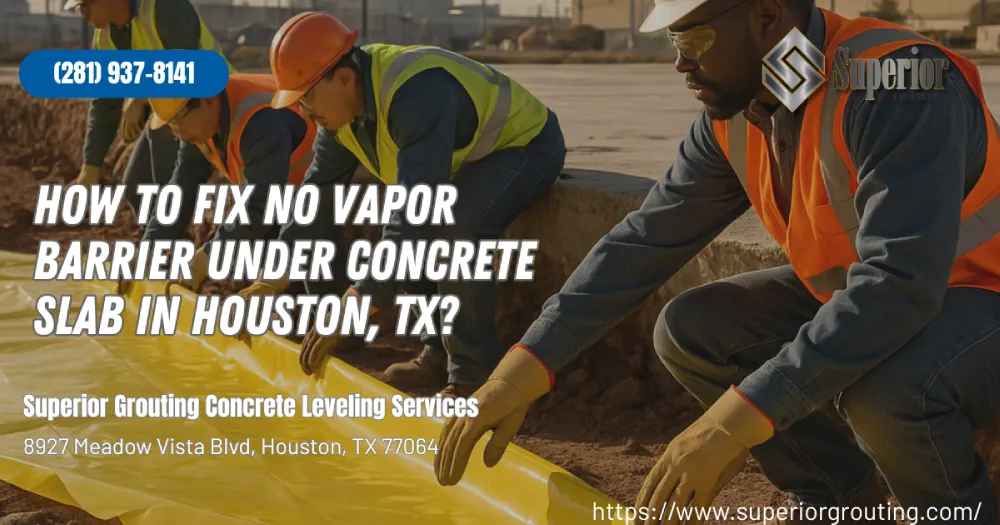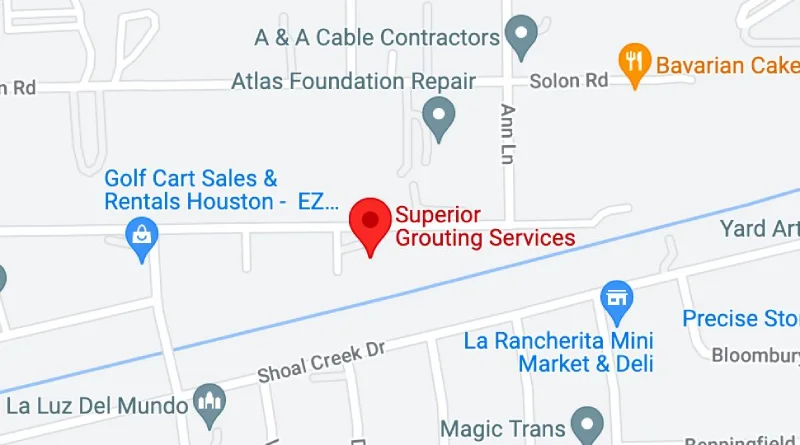How To Fix No Vapor Barrier Under Concrete Slab in Houston, TX?

Houston’s unforgiving mix of high groundwater, expansive clays, and year-round humidity creates a nonstop push of water vapor toward every concrete floor. If your slab on grade was poured without an intact vapor retarder, that moisture migration can corrode reinforcement, peel coatings, and shut down production lines. The guide below explains how to diagnose the source of moisture, interpret every moisture reading, and install an effective vapor barrier or vapor retarder that keeps the problem from ever coming back.
Key Takeaways
- Houston’s climate virtually guarantees moisture migration unless a plastic vapor barrier or equivalent system is present.
- Concrete is essential to industrial operations, but unprotected concrete vapor barriers and vapor retarders used during construction are often forgotten.
- By following ASTM test methods, choosing the right product, and ensuring correct installation, you can prevent moisture from entering the facility and protect assets for decades.
Why Houston Slabs Fight Moisture Every Day
A missing or damaged barrier between the slab and the soil sets the stage for moisture in the concrete to rise until it reaches the top surface of the slab. Houston’s climate accelerates the issue in three ways:
- Persistent dew points over 70 °F raise vapor pressure, forcing water vapor into pores of the concrete slab.
- Clay-rich soils under industrial sites swell and shrink, pumping ground moisture toward the bottom of the slab.
- Intense rainfall keeps the water table high, so a true vapor barrier is the only reliable line of defense.
Without one, you will eventually see moisture coming through the slab, adhesive failures, or high relative humidity readings that make new coatings impossible.
Step 1 – Confirm the Moisture Condition of the Slab
Never guess. Objective concrete moisture testing quantifies the amount of moisture deep within the slab and at the surface of the concrete.
- ASTM F2170 in-situ RH probes placed at 40 % depth measure moisture vapor inside the slab.
- ASTM F1869 calcium chloride kits record moisture vapor emission on the top surface of the slab.
- Handheld impedance meters quickly flag areas where excessive moisture in the concrete may exist.
If readings exceed 75 % RH or 3 lbs/1,000 ft²/24 hr, mitigation is mandatory. High results confirm the possibility that the moisture is coming up through the slab due to the lack of a vapor barrier under the concrete.
Step 2 – Identify External Contributors
Even the best barrier may struggle if external conditions keep feeding water vapor moving toward the building.
- Check grading and storm drains to minimize the amount of moisture accumulating next to perimeter walls.
- Verify subsurface drainage to lower hydrostatic pressure beneath the slab.
- Inspect expansion joints; an open joint can let water bypass an otherwise intact vapor retarder below the slab.
Step 3 – Choose an Effective Vapor Barrier or Retarder
Houston facilities typically select one of three moisture mitigation products available. Each option must deliver low vapor permeance while fitting operational schedules.
A. Sheet-Applied Vapor Barrier on Top of the Slab
A bonded 10-mil to 20-mil polyethylene or HDPE sheet creates an effective vapor barrier under the new topping or wear surface.
Pros
- Delivers the lowest water vapor permeance (≤ 0.01 perms).
- Acts as a moisture barrier and crack isolation layer.
Cons
- Raises finished floor elevation.
- Requires a brief shutdown to grind, clean, place the vapor barrier, and weld seams.
B. High-Build Epoxy or Polyurea Moisture Barrier
Thick-film coatings (≥ 20 mils) penetrated by a moisture-tolerant primer seal the concrete and block vapor migration.
Pros
- Fast return to service—polyurea systems cure in six hours.
- No elevation change.
Cons
- Surface prep must achieve ICRI CSP-3 to CSP-5.
- Moisture levels are too high above 95 % RH; a primer may not bond.
C. Integral Crystalline Retarder
Silicate-based liquids react within the slab, forming crystals that slow vapor from the soil.
Pros
- Leaves the top of the concrete unchanged.
- Allows limited vapor to escape, preventing osmotic blistering.
Cons
- Effectiveness drops when excessive moisture in the concrete exceeds 90 % RH.
- Requires extended moist curing to develop full reaction.
Step 4 – Execute the Installation
Whichever system you select, proper execution is critical:
- Mechanically profile the surface of the slab to open pores and remove laitance.
- Vacuum dust—fine debris can prevent adhesion.
- Install the vapor retarder according to the manufacturer’s spread rate or bonding instructions.
- Detail penetrations: pipes, joint edges, and column bases need boot flashings so no water vapor permeates the concrete floor and slab construction.
- Perform quality control—pull tests, spark tests, or holiday testing verify an effective vapor retarder has been achieved.
Step 5 – Validate With Post-Installation Moisture Reading
Once the barrier between the slab and the wood blocking, machinery anchors, or finish toppings is complete, re-test. An effective vapor barrier installed over the concrete floor should drop RH readings below 75 % and MVER below 3 lbs. Hold records to satisfy flooring manufacturers and insurance carriers.
Long-Term Maintenance
A vapor retarder on top of a slab is not a set-and-forget solution.
- Inspect expansion joints quarterly; recaulking prevents water vapor permeance spikes.
- Keep drains clear so ground moisture does not pool beneath the slab.
- Utilize embedded wireless sensors for continuous moisture reading within the slab.
Cost Snapshot for Commercial & Industrial Facilities
- Sheet membrane: $5–$7 / ft² installed.
- High-build epoxy: $4–$6 / ft².
- Crystalline treatment: $1.50–$2.50 / ft².
Compare that to $8–$15 / ft² to replace damaged finishes plus downtime. A properly installed vapor barrier may pay for itself in under two years.
Closing Thoughts
Need a vapor solution that meets American Concrete Institute guidelines and your production schedule? Superior Grouting’s specialists can recommend a vapor retarder, handle installation, and verify performance—keeping your floors dry and your operations on track.


